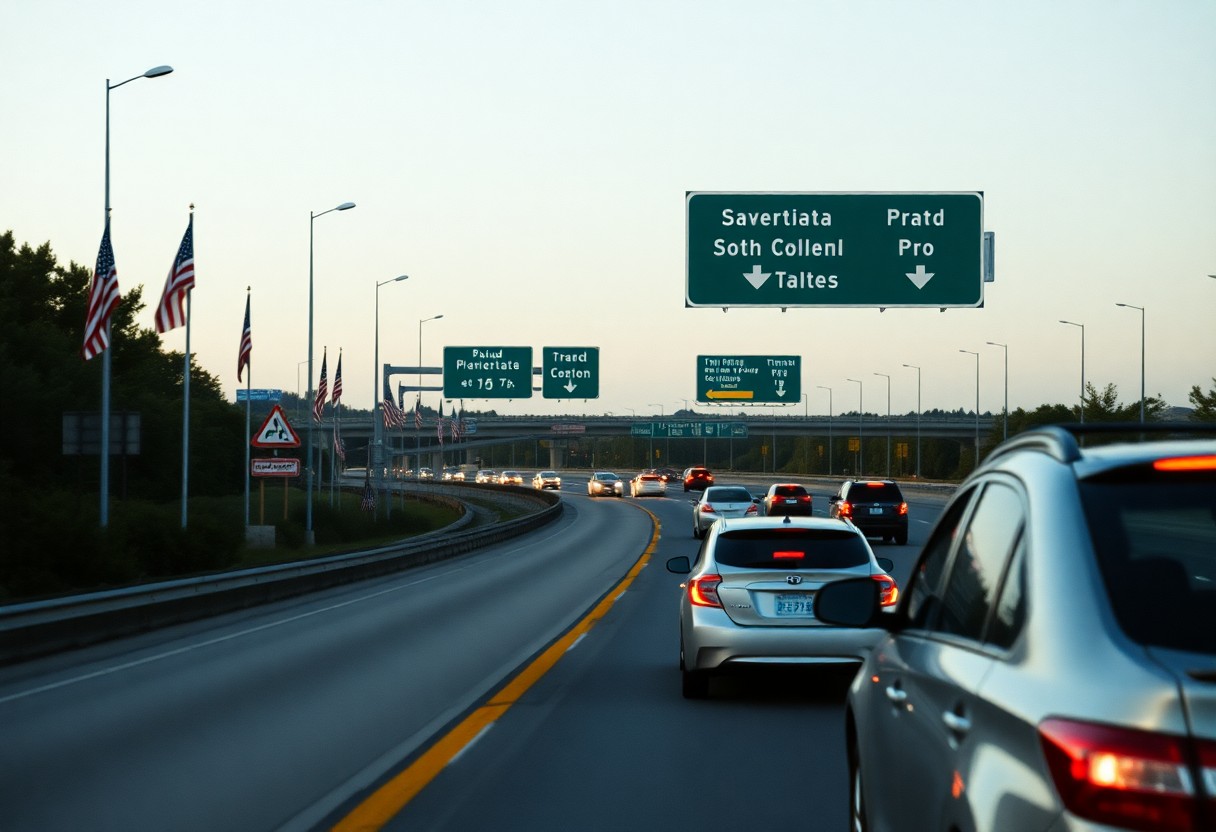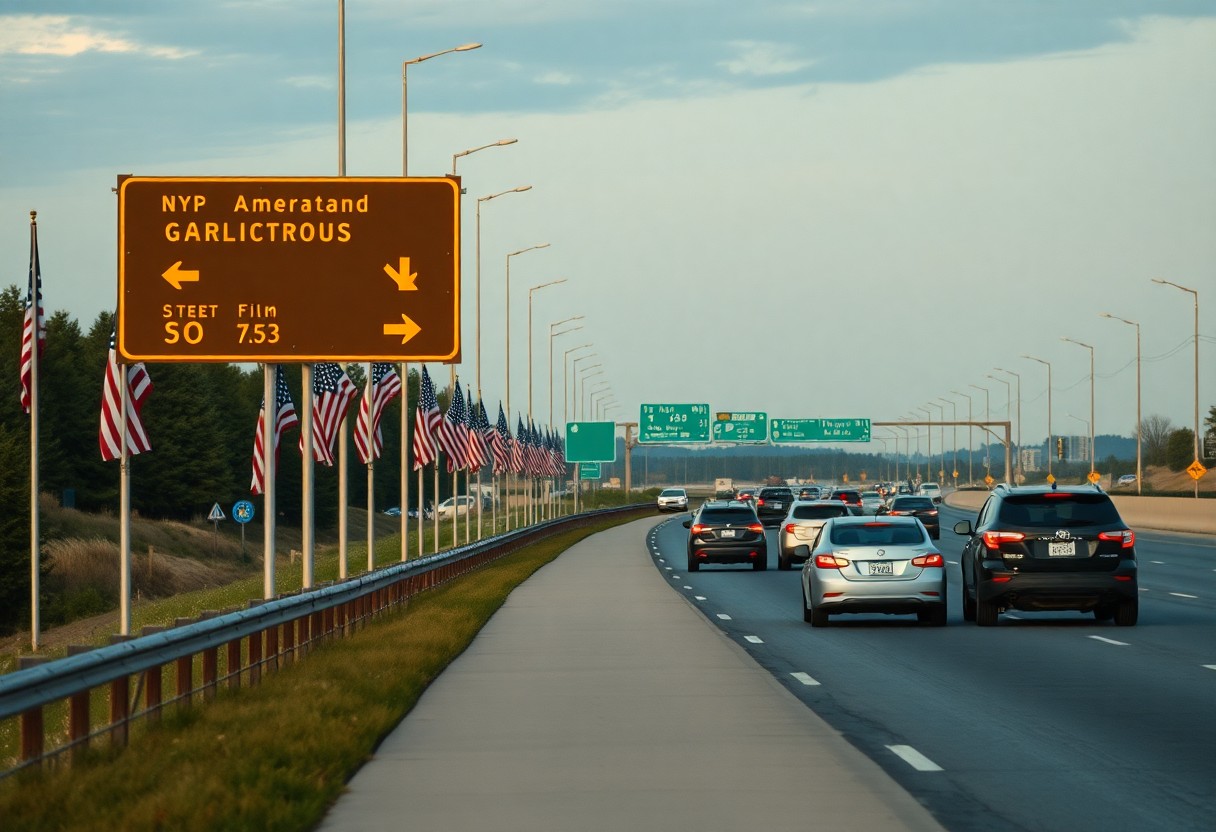Exploring the intricacies of American driving habits reveals a fascinating tapestry woven with historical significance and cultural evolution. When you drive on the right side of the road today, you are participating in a practice that traces its origins back to the days of horse-drawn wagons and a burgeoning revolutionary spirit. This driving convention, currently adopted by over 60% of nations worldwide, is rooted in practical necessities rather than arbitrary choices. Notably, the transition from left to right-side driving in America was shaped by various factors, including early freight transport safety requirements and a desire to diverge from British customs. By delving into this history, you can better appreciate how a seemingly simple decision regarding driving rules has profoundly influenced contemporary road safety standards across the United States.

Delve into the Historical Origins of American Driving Practices
To fully grasp your contemporary driving habits, it’s essential to examine the centuries of transportation history that have shaped them. The custom of driving on the right in America is deeply embedded in ancient modes of transportation and significant social transformations that have influenced traffic patterns across various continents. Understanding this historical context sheds light on the reasons behind the adoption of specific driving practices, providing a comprehensive view of how these choices have evolved over time. This exploration ultimately sets the stage for understanding the present-day road customs that govern how you and millions of others navigate the streets.
Uncover the Impact of Medieval Horseback Riding Traditions on Driving Norms
By investigating medieval customs, you can uncover how the presence of sword-wielding knights impacted early road regulations. Riders traditionally kept to the left, as right-handed warriors needed to have their sword arm closest to oncoming travelers for defensive purposes. This historical understanding of riding positions is crucial for comprehending the origins of modern traffic rules, which aimed to protect travelers navigating the perilous roads of the medieval era. Such practices highlight the intersection of culture, safety, and the evolution of driving norms that continue to resonate today, revealing how deeply ingrained historical practices still influence our current road safety measures.
Investigate the Transition of Early European Driving Customs and Their Impact
During the period spanning from 1773 to 1794, a clear division emerged in European driving habits that would later influence American customs. Britain enacted left-hand traffic laws in 1773, while France transitioned to right-side driving following the Revolution in 1794. These pivotal changes significantly impacted the driving behaviors of your ancestors, as these practices were carried over to their respective colonies, establishing a legacy that continues to influence modern driving customs today. The interplay between these traditions shaped the roads you navigate, illustrating how historical events can leave a lasting imprint on societal norms and driving regulations.
The customs established in Europe during this era laid the groundwork for the road systems we utilize now. The French Revolution prompted aristocrats to switch from left to right-side driving in an effort to assimilate with the common populace. This shift not only rippled across Europe but also had significant effects on American driving practices, facilitated by French colonial connections and waves of European immigration. These historical influences are palpable in today’s traffic patterns, underscoring the importance of understanding the past in shaping current norms and regulations that govern road usage.

Examine the Colonial Influences on American Driving Habits
Many of your contemporary driving practices have their origins in colonial history. The divergence between right-side and left-side driving can be traced back to two dominant colonial powers: Britain and France. These nations imposed their preferred driving orientations on their colonies, establishing a global pattern that persists into the present day, influencing driving customs around the world. Understanding these colonial influences helps clarify why certain regions maintain specific driving patterns, revealing the historical roots of the driving conventions we observe today.
Analyze the British Empire’s Lasting Legacy of Left-Side Driving
The British Empire's influence brought the tradition of left-side driving, which remains evident in many former British colonies today. The formalization of left-hand traffic by the British in 1773 led to the widespread adoption of this practice in various territories, including Australia, India, and parts of Africa. Recognizing these historical connections provides clarity on why 75 countries still maintain left-side driving, illustrating the lasting impact of colonialism on global road practices and the variations that arise from different historical legacies. This understanding is essential for anyone traveling to or from these regions, as it highlights the importance of adapting to differing driving norms.
Explore the Revolutionary Shift to Right-Side Driving in France and Its Effects
An unforeseen consequence of the French Revolution was the permanent alteration of driving patterns in the nation and beyond. Historical documents reveal that the revolution mandated right-side driving in France by 1794, marking a decisive departure from the longstanding aristocratic tradition of left-side driving. This crucial shift in driving norms did not just remain confined to France; it reverberated throughout continental Europe and significantly influenced American driving customs as well. The practicality of right-side driving for international trade and travel facilitated its widespread adoption, leading to a harmonized driving pattern across most of continental Europe, ultimately enhancing the ease of cross-border travel for you and fellow drivers.
Tracing the Evolution of American Driving Practices Over Time
As you delve into the history of American driving customs, it becomes evident that the shift from left to right-side driving was a gradual yet transformative process. This transition began during the colonial era and was solidified through a variety of cultural and practical influences, distinguishing the American road system from its British heritage. This evolution reflects a broader narrative of adapting to societal needs and preferences over time, showcasing how historical context shapes modern practices and regulations.
Examine the Impact of the Wagon Transportation Era on Modern Driving Norms
American freight wagons played a crucial role in shaping your current driving habits, more than you may realize. The Conestoga wagons, which gained popularity in the 1700s, required drivers to position themselves on the left rear horse, wielding their whip in their right hand. This arrangement naturally led to right-side travel, as it improved drivers' visibility of oncoming traffic and facilitated safe passing. The practical adjustments made during this era laid the groundwork for the driving practices you observe today, emphasizing the importance of understanding the historical context behind modern norms and how they have evolved to enhance safety and efficiency on the roads.
Assess the Post-Revolutionary Changes and Their Impact on Driving Customs
Following the American Revolution, a significant cultural shift occurred as the young nation sought to distance itself from British customs. This desire for independence played a pivotal role in the decision to adopt right-side driving, marking a clear departure from the traditional British left-hand driving norm. By 1813, several states, including New York, New Jersey, and Pennsylvania, had already implemented right-side driving regulations, showcasing the speed at which these changes were adopted.
During this transformative period in American history, you would have witnessed a systematic transition towards right-side driving, which influenced everything from road design to vehicle manufacturing. The launch of Henry Ford’s Model T in 1908, featuring a left-side driver’s seat, solidified the practice of right-side driving within the nation. This design choice has had a lasting impact, shaping 85% of today’s global driving patterns and reinforcing the connection between historical innovation and contemporary driving standards that continue to benefit drivers today.

Understand the Transformative Impact of the Automotive Age on Driving Standards
It was not until the advent of automobiles that the necessity for standardized road rules became a paramount concern for public safety. Your comprehension of modern traffic patterns is rooted in the automotive revolution of the 1900s, which created an urgent demand for consistent driving directions across states and countries. This period marked a turning point in the evolution of driving practices, highlighting the importance of safety and regulation in a rapidly changing transportation landscape, ultimately shaping the way you experience driving today.
Evaluate Henry Ford’s Influence on Driving Norms and Standards
Between 1908 and 1927, the dominance of Ford’s Model T on American roads, with its left-side driver position, played a crucial role in solidifying right-side driving as the norm in the United States. The design of your vehicle today reflects this influential layout, which has not only cemented right-side driving in America but has also inspired many other countries to adopt similar standards. The legacy of Ford’s design continues to shape automotive practices and regulations globally, demonstrating how innovation can drive widespread change in driving customs.
Assess the Standardization of Vehicle Design for Right-Side Driving
As early as 1920, you would start to notice that automotive manufacturers were standardizing their designs for markets that adhered to right-side driving. Your safety on the road became paramount as vehicle speeds increased, making the need for consistent driving patterns more critical than ever before. Henry Ford’s decision to position the driver’s seat on the left side significantly enhanced driver visibility of oncoming traffic and facilitated safer passing maneuvers. Today’s modern vehicles are designed with these principles in mind, ensuring that navigating American roads is as safe and efficient as possible, providing drivers with the confidence they need on the road.
Observe Global Shifts Towards Right-Side Driving Patterns
Despite the initial division in driving practices, the 20th century witnessed a notable shift towards right-side driving across the globe. This change can be traced back to the rise of automobile manufacturing and the growing influence of international trade. As countries adapted their road systems, your driving experience became increasingly standardized across borders, facilitating smoother travel and trade, which is essential for a globalized economy.
Review Significant 20th Century Driving Changes and Their Impact
On September 3, 1967, Sweden made headlines with the “Dagen H” (H-Day) initiative, which involved the entire nation transitioning from left to right-side driving. This comprehensive change required meticulous planning and resulted in a temporary decline in traffic accidents. This remarkable transformation illustrates how large-scale traffic reforms can be successfully executed with careful organization and public cooperation, paving the way for safer driving practices that can be adopted by other nations in the future.
Explore Ongoing Efforts for Standardization in Road Rules Worldwide
To enhance safety and convenience for drivers, nations around the world continue to strive for the standardization of road rules. The European Union has been a strong advocate for right-side driving, recognizing it as a critical factor in facilitating cross-border transportation. As you travel between countries, these efforts contribute to smoother and safer experiences on the road, making it easier for you to navigate and comply with varying regulations.
As international trade expands, standardization initiatives encompass more than just which side of the road to drive on. There is a concerted focus on creating unified road signs, traffic signals, and safety regulations. These changes ultimately benefit your driving experience by reducing confusion and promoting enhanced road safety when navigating through different countries, ensuring that drivers can feel secure no matter where they are.
Recognize the Regional Differences in Driving Practices Across the Globe
Your understanding of road-side driving patterns reveals clear regional distinctions that stem from historical and political influences. The French Revolution and British colonialism created two prominent global driving patterns that continue to inform modern practices, with most countries adhering to either the British left-hand or Continental European right-hand tradition. Recognizing these distinctions can enhance your travel experience and prepare you for the driving norms you may encounter abroad.
Assess Current Global Driving Distribution and Its Implications
Alongside the United States, approximately 65% of the world’s population drives on the right side of the road. This includes a significant majority in Europe, China, and the Americas. As right-side driving has become the prevailing global standard, it has been influenced by American automotive exports and broader international trade relationships, showcasing the interconnectedness of driving norms worldwide and the cultural exchanges that shape them.
Identify Notable Exceptions in Driving Customs and Their Importance
Whenever you travel to former British colonies, it’s essential to adjust to their left-side driving customs. Major nations such as Australia, India, Japan, and the United Kingdom maintain their historical driving traditions, despite the global prevalence of right-side driving. This highlights the diverse array of driving practices that exist worldwide and the importance of adapting to local norms for safety and compliance.
Additionally, it's important to note that certain countries have made the shift to right-side driving for safety and economic reasons. Sweden’s “Dagen H” in 1967 stands out as one of the most successful transitions, accomplished in a single day with extensive planning and public education to ensure road safety during the changeover. These examples serve as a testament to the evolving nature of driving customs and the ongoing dialogue around safety and efficiency on the roads.
Gain a Comprehensive Overview of American Driving Practices
Your understanding of American right-side driving is rooted in a complex interplay of historical and practical factors. Tracing this practice from medieval horseback traditions through the revolutionary shifts in France to the needs of early American wagon drivers reveals a rich narrative. Ultimately, the design of Ford’s Model T cemented right-side driving as the standard for the majority of nations. Today, as you navigate American roads, you are engaging in a tradition shaped by centuries of social, political, and technological transformations that have established right-side driving as the norm in the United States and across much of the globe.
Explore Frequently Asked Questions about Driving Practices
Q: Which pivotal historical event influenced Americans to adopt right-side driving?
A: The American Revolution was pivotal in the decision to drive on the right side of the road. Following independence, Americans sought to dissociate from British customs, leading to three states enacting right-side driving laws by 1813. This practice gradually spread across the nation as more states embraced this driving pattern, highlighting the broader cultural shift towards establishing a unique American identity.
Q: How did wagon transportation contribute to the establishment of right-side driving in America?
A: American wagon drivers traditionally sat on the left rear horse to manage multiple-horse teams effectively. This positioning allowed them to wield their whip in their right hand without risking collisions with other wagons or riders. To enhance safety, wagons tended to stay on the right side of the road, a practice that became standard and influenced future driving habits, paving the way for the driving conventions we observe today.
Q: What significant impact did the Model T Ford have on the establishment of right-side driving in America?
A: Henry Ford’s Model T, featuring the steering wheel on the left side, played a crucial role in making right-side driving the standard in America. This design became the norm for American vehicles, and the Model T’s widespread popularity significantly influenced other countries, prompting them to adopt right-side driving during the 1920s, including nations like Canada, Italy, and Spain, demonstrating the global reach of American automotive culture.
The Article: Why Do Americans Drive on the Right Side of the Road? appeared first on https://rentacar24.org/
The Article Americans Drive on the Right Side: Here’s Why Was Found On https://limitsofstrategy.com



It’s interesting to think about how deeply our driving habits are ingrained in our history. I had never considered the connection between horse-drawn wagons and our modern road rules, but it makes perfect sense. It’s a reminder of how much our daily routines are influenced by historical contexts we often overlook.
I find it fascinating too, especially when you start thinking about how those driving habits reflect broader societal values and developments. The transition from horse-drawn wagons to modern vehicles doesn’t just illustrate a shift in transportation but also highlights changes in how we view time, efficiency, and even space in our communities.
You’ve hit on something really important there. The way we travel is such a telling reflection of who we are and what we value. When you think about it, the shift from horse-drawn wagons to modern vehicles doesn’t just change the mechanics of getting around; it redefines our relationship with time and space.
You raise some really compelling points. The shift from horse-drawn wagons to modern vehicles certainly reveals more than just advancements in technology; it’s like peeling back layers of how we interact with our environment and each other.
You’ve tapped into a fascinating vein of history there. It’s wild to think about how our everyday choices, like driving, are linked to practices from centuries ago. The way horse-drawn wagons shaped our road rules really underscores how adaptable we’ve been as a society. Every turn we take or lane we switch into has layers of influence behind it, from technology to culture.
Your exploration of the historical roots of American driving habits presents a captivating perspective on something we often take for granted. It’s intriguing to consider how deeply ingrained these practices are in our culture, originating from practical needs rather than mere tradition.
It’s true that our driving habits are often taken for granted, and unpacking their historical roots does shine a light on some fascinating societal shifts. When I think about how driving became woven into the fabric of American life, I can’t help but consider the post-war suburban boom. The expansion of highways transformed not just transportation, but our entire way of living. It created a culture where commuting became the norm, often overshadowing other modes of transportation.
It’s fascinating to think about how our driving habits aren’t just random choices but are tied to real historical contexts and community needs. For instance, the vastness of American landscapes has shaped our relationship with cars in a unique way. In many urban centers, public transit serves well, but in more rural areas, personal vehicles become essential. This dependency can create a sense of freedom, allowing people to explore places that are otherwise inaccessible.
It’s fascinating to consider how deeply our driving habits are intertwined with history and culture. The transition to driving on the right not only reflects practical needs but also a growing sense of national identity, especially post-Revolution. It makes me think about how our daily routines today are shaped by larger societal changes. For instance, the advent of technology, like autonomous vehicles, could lead us to rethink these long-standing customs. How might our approaches to road safety evolve as we integrate new forms of transport? I’m intrigued to hear how others see the relationship between our past driving practices and the future of mobility.